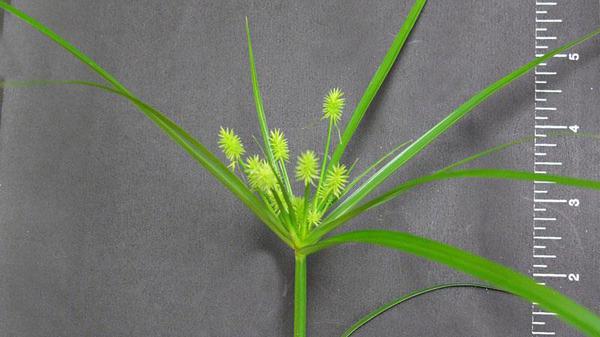Description
Cylindric sedge (Cyperus retrorsus) is an upright perennial weed that can reach heights of 20 inches. It is a very common weed in sandy and moist habitats. The seedhead is comprised of several spikelets. Each spikelet consists of a long stalk with an oblong cluster of seeds perched on the end. Cylindric sedge and globe sedge seedheads are very similar in appearance. However, globe sedge seedheads are round, whereas cylindric sedge seedheads are oblong.
Cultural Control
Sedges are weeds that resemble grasses but unlike grasses, sedges have three-sided or triangular stems. It is important to properly distinguish sedges from grasses because management is totally different. As a general rule, sedges are more of a problem in warmer climates than cooler climates. Proper identification and an understanding of the biology of sedges are necessary for effective management. Sedges are plants that thrive in wet or poorly drained soils but can survive in areas that are not wet. Because of frequent irrigation in highly maintained turf, sedges often thrive in the turfgrass environment. Sedges often become established in wet areas and spread to other areas that are not poorly drained or wet areas. Therefore, it is important to recognize areas where sedges can become established and prevent spread of these sedge species to other areas of the golf course or landscape.
Species Data
- Growth Season / Life Cycle
- Seed Arrangement on Spikes
- tightly bunched
- Seedhead Spikelet Shape
- Tuber Type
- none
Publication date: Oct. 26, 2017
Recommendations for the use of agricultural chemicals are included in this publication as a convenience to the reader. The use of brand names and any mention or listing of commercial products or services in this publication does not imply endorsement by NC State University or N.C. A&T State University nor discrimination against similar products or services not mentioned. Individuals who use agricultural chemicals are responsible for ensuring that the intended use complies with current regulations and conforms to the product label. Be sure to obtain current information about usage regulations and examine a current product label before applying any chemical. For assistance, contact your local N.C. Cooperative Extension county center.
N.C. Cooperative Extension prohibits discrimination and harassment regardless of age, color, disability, family and marital status, gender identity, national origin, political beliefs, race, religion, sex (including pregnancy), sexual orientation and veteran status.








